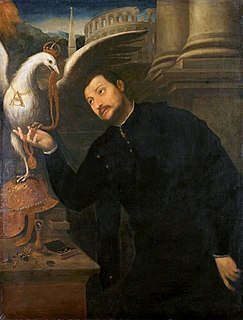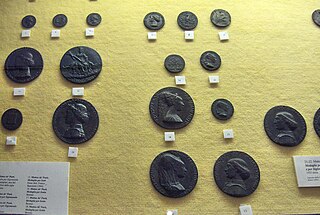 W
WAntonio Abondio (1538–1591) was an Italian sculptor, best known as a medallist and as the pioneer of the coloured wax relief portrait miniature.
 W
WLeon Battista Alberti was an Italian Renaissance humanist author, artist, architect, poet, priest, linguist, philosopher, and cryptographer; he epitomised the nature of those identified now as polymaths.
 W
WValerio Belli, also known as Valerio Vicentino, was a celebrated medallist, gem engraver,goldsmith, who with Giovanni Bernardi, who was twenty years younger, was the leading specialist in intaglios engraved in rock crystal, a difficult luxury form which Belli pioneered. These were highly sought after by wealthy Italian collectors. Though described as being "engraved", the intaglios are cut by drills, sometimes quite deeply, and developed their style from classical coins and engraved gems, to give "smoothly and eloquently orchestrated figural compositions". Castings of many of the crystal carvings were taken in wax and them used to make metal plaquettes, which Belli also designed and made de novo. He was described as a goldsmith, though no surviving works are known, and had some role at the Papal mint, though no coins are clearly attributable to him.
 W
WGentile Bellini was an Italian painter of the school of Venice. He came from Venice's leading family of painters, and at least in the early part of his career was more highly regarded than his younger brother Giovanni Bellini, the reverse of the case today. From 1474 he was the official portrait artist for the Doges of Venice, and as well as his portraits he painted a number of very large subjects with multitudes of figures, especially for the Scuole Grandi of Venice, wealthy confraternities that were very important in Venetian patrician social life.
 W
WGiovanni Bernardi, also known as Giovanni da Castel Bolognese and as Giovanni da Castelbolognese, was an Italian gem engraver and medallist who was born in Castel Bolognese, Italy. He was the son of a goldsmith and by 1530 had moved to Rome, where he had a position in the Papal mint, which also allowed him time to work for other patrons. These included Cardinal Ippolito de' Medici (1511–35), Pope Clement VII (1523–34), Cardinal Alessandro Farnese, the future Pope Paul III, as well as his grandson, also called Cardinal Alessandro Farnese. He was "a skillful composer of elegant nudes in elaborate scenes".
 W
WBertoldo di Giovanni was an Italian sculptor and medallist.
 W
WJacopo Caraglio, Giovanni Jacopo Caraglio or Gian Giacomo Caraglio known also as Jacobus Parmensis and Jacobus Veronensis was an venetian engraver, goldsmith and medallist, born at Verona or Parma. His career falls easily into two rather different halves: he worked in Rome from 1526 or earlier as an engraver in collaboration with leading artists, and then in Venice, before moving to spend the rest of his life as a court goldsmith in Poland, where he died.
 W
WGiannino Castiglioni was an Italian sculptor and medallist. He worked mostly in monumental and funerary sculpture; his style was representational, and far from the modernist and avant-garde trends of the early twentieth century.
 W
WBenvenuto Cellini was an Italian goldsmith, sculptor, and author. His best-known extant works include the Cellini Salt Cellar, the sculpture of Perseus with the Head of Medusa, and his autobiography, which has been described as "one of the most important documents of the 16th century."
 W
WCostanzo da Ferrara (1450–1524) was an Italian painter and medalist, born in Ferrara, but working mainly in Naples.
 W
WLaura Cretara is an Italian medallist and engraver.
 W
WGianfrancesco Enzola was an Italian medallist, known as il Parmense.
 W
WAdriano Fiorentino (1440–1499), also known as Adriano di Giovanni De' Maestri, was an Italian medallist and sculptor.
 W
WAnnibale Fontana (1540–1587) was an Italian sculptor, medallist and crystal-worker.
 W
WFrancesco Francia, whose real name was Francesco Raibolini was an Italian painter, goldsmith, and medallist from Bologna, who was also director of the city mint.
 W
WVittore Gambello (1460–1537) was an Italian sculptor and medallist.
 W
WOttone Hamerani (1694–1768), also known as Otto Hamerani, was an Italian medallist.
 W
WFrancesco Laurana, also known as Francesco de la Vrana was a Dalmatian sculptor and medallist. He is considered both a Croatian and an Italian sculptor. Though born in the territory of the Republic of Venice, he spent his mature career at the other end of Italy, moving between Naples and Sicily, and Urbino, and finally in southern France, where he died.
 W
WLeone Leoni was an Italian sculptor of international outlook who travelled in Italy, Germany, Austria, France, Spain and the Netherlands. Leoni is regarded as the finest of the Cinquecento medallists. He made his reputation in commissions he received from the Habsburg monarchs Charles V, Holy Roman Emperor and Philip II of Spain. His usual medium was bronze, although he also worked in marble and alabaster, carved gemstones and probably left some finished work in wax, as well as designing coins. He mainly produced portraits, and was repeatedly used by the Spanish, and also the Austrian, Habsburgs.
 W
WAlfonso Lombardi, also known as Lombardi da Lucca, Alfonso da Ferrara and as Alfonso Lombardo, was an Italian sculptor and medalist who was born in Ferrara, Italy in 1497, and died in Bologna in 1537. He was very active in Bologna where he created a number of works that are still present in the most important churches of that city. Giorgio Vasari dedicated a chapter to Lombardi in his Vite.
 W
WGasparo Molo was an Italian goldsmith and planisher, chiefly known as a medalist, whose biography is very obscure.
 W
WGiovanni Maria Mosca or Giovanni Padovano was an Italian sculptor and medallist, active between 1515 and 1573, initially in the Veneto and after 1529 in Poland, where his first name was rendered Jan.
 W
WGaetano Orsolini was an Italian sculptor, medallist and engraver.
 W
WMatteo di Andrea de' Pasti (1420-1467/1468) was an Italian sculptor and medalist.
 W
WPisanello, born Antonio di Puccio Pisano or Antonio di Puccio da Cereto, also erroneously called Vittore Pisano by Giorgio Vasari, was one of the most distinguished painters of the early Italian Renaissance and Quattrocento. He was acclaimed by poets such as Guarino da Verona and praised by humanists of his time, who compared him to such illustrious names as Cimabue, Phidias and Praxiteles.
 W
WBenedetto Pistrucci was an Italian gem-engraver, medallist and coin engraver, probably best known for his Saint George and the Dragon design for the British sovereign coin. Pistrucci was commissioned by the British government to create the large Waterloo Medal, a project which took him thirty years to complete.
 W
WDomenico Poggini (1520–1590) was an Italian sculptor, engraver, medallist, goldsmith, and poet.
 W
WAndrea della Robbia was an Italian Renaissance sculptor, especially in ceramics.
 W
WGiovanni della Robbia (1469–1529) was an Italian Renaissance ceramic artist.
 W
WGiovanni Cristoforo Romano (1456–1512) was an Italian Renaissance sculptor and medallist.
 W
WMassimiliano Soldani or Massimiliano Soldani Benzi was an Italian baroque sculptor and medallist, mainly active in Florence. Born at Montevarchi, the son of a Tuscan cavalry captain, Soldani was employed by the Medici for his entire career.